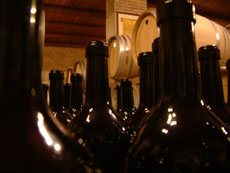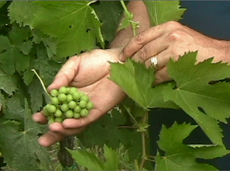|
Strologo's Famous Wine of Camerano
By ZAN LANOUETTE
July 2006
CAMERANO, Italy -- Silvano Strologo’s
love for wine goes beyond enjoying the taste, texture and effects
and ventures into the realm of passion and life dedication.
He was born and raised on a vineyard, and is proud of the history
and the future held within its precious soil.
|
Related
Sites |
|
|
|
| |
Fun Facts
|
Strologo's four wine categories
1. Vino Da Tavola is the lowest class of wine,
a wine made by the producer as he sees fit to make it. |
| 2.Vino
a Indicazione Geografica is a wine produced in a specific
area. |
3.
Vino a Denominazione di Origine
Controllata are produced in specific well-defined regions,
according to specific rules designed to preserve the traditional
wine-making practices of the individual regions.
4.Vino a Denominazione di Origine Controllata e Garantita.
Allowable yields are generally lower, and DOCG wines must pass
an evaluation of a tasting committee before they can be bottled. |
| |
Silvano Strologo’s winery is open
year-round.
Vigne e Cantina
Via Osimana, 89-60021 Camerano
Telephone:
+39 071-73.11.04
s.strologo@libero.it
|
|
 |
The
winery was established in the 1960s by a small family of farmers
who moved from the Loreto region. The head of the family,
Sante Giulio Strologo, chose the hilly location for the soil, sunshine
and weather. The careful cultivation of the Montepulciano
vines yielded amazing Rosso Conero red wine, and a star was born.
In the 1990s, the Strologo company passed on to the son of Sante
Giulio, Silvano, who modernized the wine- producing processes in
1998 and entered the competitive market as the Silvano Strogolo
Wine Company. Through mass production, Strologo made it possible
to bottle, ship and sell major quantities of wine while maintaining
that small region feel.
Strologo, one day in July, casts a careful eye over his rows of
grape vines and tugs off any offending dead leaves within his reach
as he talks about his true love—wine. His oenologist
(wine specialist), Giancarlo Soverchia, chimes in drawing from his
vast knowledge of grapes, vines and wine.
“Each grape leaf is like a fingerprint,” Soverchia explains
of the native Montepulciano grapes, in Italian, through an interpreter.
“You can distinguish grapes by looking at their leaves.
You can see tiny hairs and cuts and every grape has a different
smell.”
The grapes grown on the Strologo farm are not all of Italian origin.
In the 1870s, swarms of insects called Phylloxera invaded Europe
and began destroying the grape vines. The European wine producers
looked to America and its vines because the American plants had
built up a tolerance to the insects. Roots were shipped over
and planted, and prosperity was restored. Today’s plants
are a hybrid of American and Italian vines. Their hybrid nature
allows the plants to have resistance but to still flourish in the
hot climate.
Strologo follows the traditions handed
down to him for the processing of his grapes and wine. Situated
on approximately 37 acres about 2,690 feet above sea level, the
Strologo winery has about 5,000 plants per 2.4 acres. The
soil is calcified on a clay base and perfect, according to the producers,
for the 85 percent of Montepulciano and 15 percent of Sangiovese
vines grown there.
Strologo’s production rules include producing limited quantities,
manually picking the over-matured grapes, soft treading while
processing and, finally, lengthy fermentation at controlled temperatures
in French oak barrels. “The French oak barrels give
the wine a nice, subtle flavor,” Silvano explains to the
interpreter as he leans upon a barrel. “We do not
use American oak because it gives wine a coconut flavor.
>>go to page
2
|



